INSTITUT SUPERIEUR D'ANTHROPOLOGIE
INSTITUT OF ANTHROPOLOGY
COURS ONLINE – COURS A DISTANCE
INSCRIPTIONS OUVERTES
REGISTER NOW
POLOGNE - 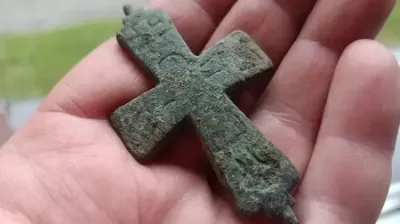 - Woźniki - Archaeologists have unearthed a rare enkolpion -a medallion with an icon in the center worn around the neck by Eastern Orthodox and Eastern Catholic bishops- in Woźniki, located in the Lubliniec district of Poland’s Silesian Voivodeship. Archaeologists, including researchers from the University of Łódz, have unearthed a remarkable enkolpion, a cross-shaped reliquary, during their excavations. These relics were discovered in what is believed to be a knightly residence dating back to the 14th and 15th centuries. Archaeologists found, among others: clay vessels and iron objects constituting the equipment of the manor – they included door fittings, a padlock, a key, nails, hooks, staples, and a carder. The military function of the object was confirmed by such monuments as three iron stirrups, part of a horseshoe, several crossbow bolt heads, and fragments of a cord. Several silver coins and elements of a belt suit were also discovered. The exceptional find in Woźniki is an enkolpion crafted from a copper alloy. These reliquaries, worn by Christians on their chests, typically housed relics or quotes from the Holy Scriptures. Excavations at Woźniki have exposed the remains of the lower level of a wooden building with a domed furnace, which likely heated the residence, initially a princely court at the end of the 13th century and later a private knight’s dwelling. The stronghold in Woźniki, whose origins can be tentatively dated to the end of the 13th century, most likely burned down around the first half of the 15th century.
- Woźniki - Archaeologists have unearthed a rare enkolpion -a medallion with an icon in the center worn around the neck by Eastern Orthodox and Eastern Catholic bishops- in Woźniki, located in the Lubliniec district of Poland’s Silesian Voivodeship. Archaeologists, including researchers from the University of Łódz, have unearthed a remarkable enkolpion, a cross-shaped reliquary, during their excavations. These relics were discovered in what is believed to be a knightly residence dating back to the 14th and 15th centuries. Archaeologists found, among others: clay vessels and iron objects constituting the equipment of the manor – they included door fittings, a padlock, a key, nails, hooks, staples, and a carder. The military function of the object was confirmed by such monuments as three iron stirrups, part of a horseshoe, several crossbow bolt heads, and fragments of a cord. Several silver coins and elements of a belt suit were also discovered. The exceptional find in Woźniki is an enkolpion crafted from a copper alloy. These reliquaries, worn by Christians on their chests, typically housed relics or quotes from the Holy Scriptures. Excavations at Woźniki have exposed the remains of the lower level of a wooden building with a domed furnace, which likely heated the residence, initially a princely court at the end of the 13th century and later a private knight’s dwelling. The stronghold in Woźniki, whose origins can be tentatively dated to the end of the 13th century, most likely burned down around the first half of the 15th century.
A rare reliquary discovered during excavations in Poland - Arkeonews
TURQUIE – 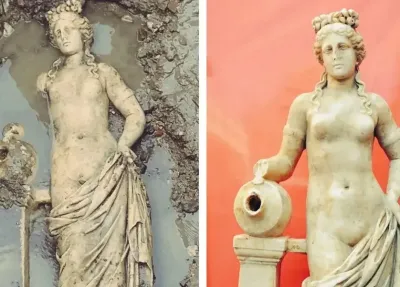 Amastris - A statue of the goddess Aphrodite was uncovered during excavations carried out in the Ancient Greek city of Amastris in today’s Turkey. The statue, found three meters below the surface was originally thought to depict a nymph (water fairy). However, archaeologists in Turkey have determined that the statue depicts the Ancient Greek goddess of love and beauty, identified with Venus by the Romans. The 1.53-meter-tall statue is thought to date back to the 2nd century A.D.
Amastris - A statue of the goddess Aphrodite was uncovered during excavations carried out in the Ancient Greek city of Amastris in today’s Turkey. The statue, found three meters below the surface was originally thought to depict a nymph (water fairy). However, archaeologists in Turkey have determined that the statue depicts the Ancient Greek goddess of love and beauty, identified with Venus by the Romans. The 1.53-meter-tall statue is thought to date back to the 2nd century A.D.
Statue of Greek Goddess Aphrodite Uncovered in Turkey (greekreporter.com)
ANGLETERRE – 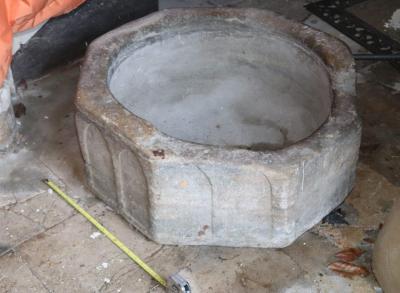 Ryde - The original font from the 1829 church survives and will be carefully conserved and put on display in the future. But hidden in a corner of the church, the team found another stone font. Recognising that this could be older than the original St Thomas’s chapel built in 1719, they called for advice from archaeologists of the Vectis Archaeological Trust. The result was quite a surprise. This font is more than 800 years old. An examination by the archaeologists compares this font with some of the products of Purbeck craftsmen who were once mining high-quality limestone in the Kimmeridge/Swanage area of south Dorset. Here, they were skilfully sculpting and exporting fonts and other church components at the close of Norman times. Fonts of this early period were sometimes sculpted to show shallow relief images of an arcade of Norman arches. These were much akin to those depicted on the Bayeux Tapestry. Hexagonal in form, this Ryde font displays 2 arches on each of its 8 faces. A clue to its date comes from a closer look at these lightly carved arches. Each is slightly pointed, a concession to the adoption of the Gothic arch, a design embraced by ‘Early English’ church-builders after introduction from France, in the year 1185. Early Norman fonts were largely square or round, and it appears that the hexagonal form may have gained favour a little later in Norman times. On the Isle of Wight, fonts of this period are certainly rare.
Ryde - The original font from the 1829 church survives and will be carefully conserved and put on display in the future. But hidden in a corner of the church, the team found another stone font. Recognising that this could be older than the original St Thomas’s chapel built in 1719, they called for advice from archaeologists of the Vectis Archaeological Trust. The result was quite a surprise. This font is more than 800 years old. An examination by the archaeologists compares this font with some of the products of Purbeck craftsmen who were once mining high-quality limestone in the Kimmeridge/Swanage area of south Dorset. Here, they were skilfully sculpting and exporting fonts and other church components at the close of Norman times. Fonts of this early period were sometimes sculpted to show shallow relief images of an arcade of Norman arches. These were much akin to those depicted on the Bayeux Tapestry. Hexagonal in form, this Ryde font displays 2 arches on each of its 8 faces. A clue to its date comes from a closer look at these lightly carved arches. Each is slightly pointed, a concession to the adoption of the Gothic arch, a design embraced by ‘Early English’ church-builders after introduction from France, in the year 1185. Early Norman fonts were largely square or round, and it appears that the hexagonal form may have gained favour a little later in Norman times. On the Isle of Wight, fonts of this period are certainly rare.
LOST MEDIEVAL FONT FOUND AT RYDE'S ST THOMAS' CHURCH - Island Echo - 24hr news, 7 days a week across the Isle of Wight
IRAN –  - A team of archaeologists in northwest Iran has unearthed parts of a ruined fortress, which is estimated to date from the Kingdom of Urartu, an Iron Age realm once extended over the modern frontiers of Turkey, Iran, Iraq, and Armenia.
- A team of archaeologists in northwest Iran has unearthed parts of a ruined fortress, which is estimated to date from the Kingdom of Urartu, an Iron Age realm once extended over the modern frontiers of Turkey, Iran, Iraq, and Armenia.
Archaeological work sheds new light on ruins believed to date from Urartu epoch in northwest Iran - Tehran Times
ITALIE – 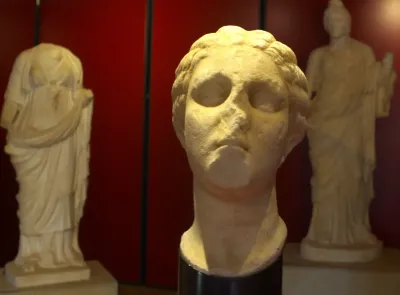 Castel di Tusa - Over the past 70 years, archaeologists here have revealed the contours of an ancient city that flourished for centuries in the hills behind Castel di Tusa. This site, known as Halaesa during antiquity, is not yet often visited by tourists. But what makes Halaesa special is how recent many of its discoveries are — plus the prospect of more to come. Just five years ago, researchers announced they'd located a Greek-Roman theater built into the flank of the ancient hilltop city. As the excavations at Halaesa continue, a clearer picture of the ancient city has started to come together. “We have the main road coming up this way and the cross streets are stepped streets like that,” said Jonathan Prag, a professor of ancient history at the University of Oxford, as he guided Courthouse News through the site this summer. He pointed to sections of street stones, first laid in the ground centuries ago. There were drainage canals, an aqueduct to carry water from the mountains and the large theater recently discovered by archaeologists. At one point, Halaesa was home to 6,000 residents, a major settlement by ancient standards.
Castel di Tusa - Over the past 70 years, archaeologists here have revealed the contours of an ancient city that flourished for centuries in the hills behind Castel di Tusa. This site, known as Halaesa during antiquity, is not yet often visited by tourists. But what makes Halaesa special is how recent many of its discoveries are — plus the prospect of more to come. Just five years ago, researchers announced they'd located a Greek-Roman theater built into the flank of the ancient hilltop city. As the excavations at Halaesa continue, a clearer picture of the ancient city has started to come together. “We have the main road coming up this way and the cross streets are stepped streets like that,” said Jonathan Prag, a professor of ancient history at the University of Oxford, as he guided Courthouse News through the site this summer. He pointed to sections of street stones, first laid in the ground centuries ago. There were drainage canals, an aqueduct to carry water from the mountains and the large theater recently discovered by archaeologists. At one point, Halaesa was home to 6,000 residents, a major settlement by ancient standards.
Buried ancient city slowly emerges from Sicilian dirt | Courthouse News Service
SUISSE – 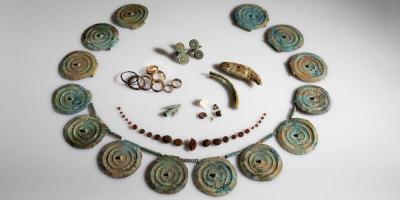 Frauenfeld - Metal detectorist Franz Zahn was sweeping a newly harvested carrot field in Switzerland when he discovered a trove of Bronze Age jewelry. For years, he has been searching for treasure in Güttingen, a town in the canton of Thurgau in northeastern Switzerland. So when he unearthed several decorative bronze discs over the summer, he quickly reached out to the local archaeology office. With the landowner’s permission, researchers cut out a small block of soil and brought it back to their lab in the nearby city of Frauenfeld. There, they carefully worked through the dirt layer by layer, slowly uncovering even more artifacts. They identified 14 bronze discs, 2 double-spiral finger rings, more than 100 tiny amber beads and wire spirals made of gold. Local officials announced the discovery earlier this week. The beads were about the size of pinheads, and archaeologists had to remove each one from the soil block using tweezers. The “eye-catching” discs were likely once part of a necklace, according to a translated statement from the archaeology office. Each one had three ribs, a spike in the middle and a narrow hole that would have accommodated a piece of thread or a leather strap. The researchers suspect a gold spiral would have been strung between each disc as a spacer. “These are typical ‘costume jewelry’ from the Bronze Age—more precisely the Middle Bronze Age around 1500 B.C.E.,” per the statement. In addition to the jewelry, researchers recovered a beaver tooth, a bear tooth, bits of polished ore, a fossilized shark tooth, a rock crystal, a bronze arrowhead and a small ammonite. They don’t know what these other artifacts were used for or whether they were intentionally buried with the jewelry some 3,500 years ago. However, they suspect these items may have been a “collection of curiosities,” perhaps worn as some sort of protective amulet. Since they didn’t find human remains or any evidence of a grave at the site, the archaeologists concluded that someone had buried the items in an organic container that disintegrated over time. They suspect the artifacts once belonged to a “rich woman with a passion for collecting,” per the statement.
Frauenfeld - Metal detectorist Franz Zahn was sweeping a newly harvested carrot field in Switzerland when he discovered a trove of Bronze Age jewelry. For years, he has been searching for treasure in Güttingen, a town in the canton of Thurgau in northeastern Switzerland. So when he unearthed several decorative bronze discs over the summer, he quickly reached out to the local archaeology office. With the landowner’s permission, researchers cut out a small block of soil and brought it back to their lab in the nearby city of Frauenfeld. There, they carefully worked through the dirt layer by layer, slowly uncovering even more artifacts. They identified 14 bronze discs, 2 double-spiral finger rings, more than 100 tiny amber beads and wire spirals made of gold. Local officials announced the discovery earlier this week. The beads were about the size of pinheads, and archaeologists had to remove each one from the soil block using tweezers. The “eye-catching” discs were likely once part of a necklace, according to a translated statement from the archaeology office. Each one had three ribs, a spike in the middle and a narrow hole that would have accommodated a piece of thread or a leather strap. The researchers suspect a gold spiral would have been strung between each disc as a spacer. “These are typical ‘costume jewelry’ from the Bronze Age—more precisely the Middle Bronze Age around 1500 B.C.E.,” per the statement. In addition to the jewelry, researchers recovered a beaver tooth, a bear tooth, bits of polished ore, a fossilized shark tooth, a rock crystal, a bronze arrowhead and a small ammonite. They don’t know what these other artifacts were used for or whether they were intentionally buried with the jewelry some 3,500 years ago. However, they suspect these items may have been a “collection of curiosities,” perhaps worn as some sort of protective amulet. Since they didn’t find human remains or any evidence of a grave at the site, the archaeologists concluded that someone had buried the items in an organic container that disintegrated over time. They suspect the artifacts once belonged to a “rich woman with a passion for collecting,” per the statement.
Metal Detectorist Unearths Bronze Age Jewelry in Swiss Carrot Field | Smart News| Smithsonian Magazine
ALLEMAGNE – 
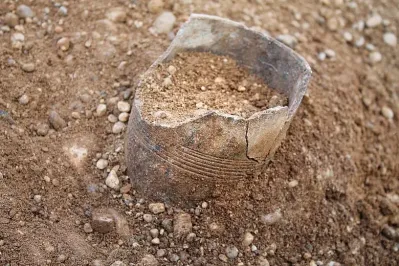 Munich - Archaeologists have discovered an ancient Celtic village and evidence of a smaller Roman settlement in Munich, Germany. The 2,300-year-old Celtic village, discovered at a field in the northern suburbs of Munich, is the first entirely coherent Celtic village discovered in the German city-state of Bavaria. The Celts of the La Tène civilization, who were prosperous in the late Iron Age around 450 BC, lived in the settlement until 1000 AD. The Celtic peoples first inhabited the area that is now Bavaria, but the Romans eventually overcame them and integrated it into their empire. During an archaeological investigation as part of the development of a new residential area, an above-average number of house plans from former settlements were discovered. These post holes, now visible as circles in the gravel, are the last remains of individual mine houses. They provide impressive evidence that around 500 people lived in today’s Feldmoching district as early as the Iron Age – an enormous number for that time. A massive structure measuring 65 by 65 feet stood in the center of the community and was surrounded by wooden arcades that resembled columns. According to Matthias Pfeil, the locals may have gathered there for prayers. It was reportedly a kind of town hall for the people. The houses were of different sizes and different floor plans can be seen. Traces of historical clay, which is still used as filling material in building houses, suggest that their residents lived in half-timbered wooden houses. The settlement lasted for a long time. The archaeologists uncovered two groups of graves from the late Iron Age (450 to 15 BC) and the Roman Empire (3rd/4th century AD). These burial graves prove that the area must have been fertile for centuries and that agriculture was also practiced there. At the feet of a buried person from the late Roman period, pieces of tableware including a plate, an almost intact handle jug, and a drinking cup made of soapstone were found. An unusual find is the blade of a sickle, as tools are rarely found in graves. The burials belong to a scattered Roman settlement from the 3rd and 4th centuries Archaeologists also discovered an enamel brooch, ceramics in one of the burials, and a beautifully wrought bronze buckle in one of the wells. Why at the end of the Roman Empire everyone suddenly left the field and no one built a large settlement there to this day could be related to climate changes in the region. The Feldmoching excavation therefore provides new, important data to various research disciplines.
Munich - Archaeologists have discovered an ancient Celtic village and evidence of a smaller Roman settlement in Munich, Germany. The 2,300-year-old Celtic village, discovered at a field in the northern suburbs of Munich, is the first entirely coherent Celtic village discovered in the German city-state of Bavaria. The Celts of the La Tène civilization, who were prosperous in the late Iron Age around 450 BC, lived in the settlement until 1000 AD. The Celtic peoples first inhabited the area that is now Bavaria, but the Romans eventually overcame them and integrated it into their empire. During an archaeological investigation as part of the development of a new residential area, an above-average number of house plans from former settlements were discovered. These post holes, now visible as circles in the gravel, are the last remains of individual mine houses. They provide impressive evidence that around 500 people lived in today’s Feldmoching district as early as the Iron Age – an enormous number for that time. A massive structure measuring 65 by 65 feet stood in the center of the community and was surrounded by wooden arcades that resembled columns. According to Matthias Pfeil, the locals may have gathered there for prayers. It was reportedly a kind of town hall for the people. The houses were of different sizes and different floor plans can be seen. Traces of historical clay, which is still used as filling material in building houses, suggest that their residents lived in half-timbered wooden houses. The settlement lasted for a long time. The archaeologists uncovered two groups of graves from the late Iron Age (450 to 15 BC) and the Roman Empire (3rd/4th century AD). These burial graves prove that the area must have been fertile for centuries and that agriculture was also practiced there. At the feet of a buried person from the late Roman period, pieces of tableware including a plate, an almost intact handle jug, and a drinking cup made of soapstone were found. An unusual find is the blade of a sickle, as tools are rarely found in graves. The burials belong to a scattered Roman settlement from the 3rd and 4th centuries Archaeologists also discovered an enamel brooch, ceramics in one of the burials, and a beautifully wrought bronze buckle in one of the wells. Why at the end of the Roman Empire everyone suddenly left the field and no one built a large settlement there to this day could be related to climate changes in the region. The Feldmoching excavation therefore provides new, important data to various research disciplines.
2,300 Years Old First Complete Ancient Celtic Village and Roman Settlement Discovered in Munich - Arkeonews
BRESIL -  Manaus - The rock carvings are not usually visible because they are covered by the waters of the Negro River, whose flow recorded its lowest level in 121 years last week. The surfacing of the engravings on the riverbank have delighted scientists and the general public alike but also raised unsettling questions. The engravings comprise an archaeological site of “great relevance,” said Jaime Oliveira of the Brazilian Institute of Historical Heritage (Iphan). They are at a site known as Praia das Lajes and were first seen in 2010, during another period of drought not as severe as the current one. The rock carvings appear against a backdrop of dense jungle, with the low brownish waters of the Negro River flowing nearby. Most of the engravings are of human faces, some of them rectangular and others oval, with smiles or grim expressions. “The site expresses emotions, feelings, it is an engraved rock record, but it has something in common with current works of art,” said Oliveira. For Beatriz Carneiro, historian and member of Iphan, Praia das Lajes has an “inestimable” value in understanding the first people who inhabited the region, a field still little explored. “Unhappily it is now reappearing with the worsening of the drought,” Carneiro said. “Having our rivers back (flooded) and keeping the engravings submerged will help preserve them, even more than our work.”
Manaus - The rock carvings are not usually visible because they are covered by the waters of the Negro River, whose flow recorded its lowest level in 121 years last week. The surfacing of the engravings on the riverbank have delighted scientists and the general public alike but also raised unsettling questions. The engravings comprise an archaeological site of “great relevance,” said Jaime Oliveira of the Brazilian Institute of Historical Heritage (Iphan). They are at a site known as Praia das Lajes and were first seen in 2010, during another period of drought not as severe as the current one. The rock carvings appear against a backdrop of dense jungle, with the low brownish waters of the Negro River flowing nearby. Most of the engravings are of human faces, some of them rectangular and others oval, with smiles or grim expressions. “The site expresses emotions, feelings, it is an engraved rock record, but it has something in common with current works of art,” said Oliveira. For Beatriz Carneiro, historian and member of Iphan, Praia das Lajes has an “inestimable” value in understanding the first people who inhabited the region, a field still little explored. “Unhappily it is now reappearing with the worsening of the drought,” Carneiro said. “Having our rivers back (flooded) and keeping the engravings submerged will help preserve them, even more than our work.”
Drought in Brazil’s Amazon reveals ancient engravings | Malay Mail
GRECE – 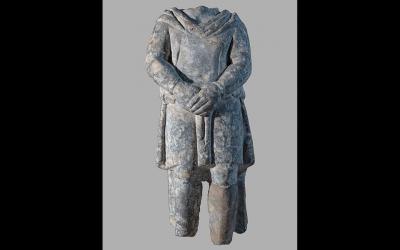 - An unknown statue of a “barbarian,” the likes of which do not exist in Greece, was unveiled for the first time on Friday. The headless statuette from the 2nd century found in the warehouses of the Athens Ephorate of Antiquities at Hadrian’s Library is rare not only because it was carved from black marble, but also because of the figure’s apparent posture of submission.“Sculptures like this are associated with the projection of the Roman emperor’s power over foreign peoples,” explains Dimitris Sourlas, an archaeologist at the agency. “Although small in size, it stands out in the sea of white Attic sculptures kept in warehouses because of the dark stone,” said Sourlas, who presented the headless statue on Friday at the Kanellopoulou Museum, during a scientific meeting on the history and topography of the northern slope of the Acropolis.
- An unknown statue of a “barbarian,” the likes of which do not exist in Greece, was unveiled for the first time on Friday. The headless statuette from the 2nd century found in the warehouses of the Athens Ephorate of Antiquities at Hadrian’s Library is rare not only because it was carved from black marble, but also because of the figure’s apparent posture of submission.“Sculptures like this are associated with the projection of the Roman emperor’s power over foreign peoples,” explains Dimitris Sourlas, an archaeologist at the agency. “Although small in size, it stands out in the sea of white Attic sculptures kept in warehouses because of the dark stone,” said Sourlas, who presented the headless statue on Friday at the Kanellopoulou Museum, during a scientific meeting on the history and topography of the northern slope of the Acropolis.
Ephorate presents rare headless ‘barbarian’ | eKathimerini.com
SOUDAN –  Ghazali - The medieval monastic site of Ghazali is one of the best-preserved archaeological sites in Sudan, which was known as Nubia in the Middle Ages. Located in the Wadi Abu Dom region of the Bayuda desert, in the northern province of Sudan, about 20 km from the modern town of Karima. Between 2012 and 2018, a Polish-Sudanese team from the Polish Centre of Mediterranean Archaeology, University of Warsaw (PCMA UW) headed by Professor Artur Obłuski investigated a medieval (7th–13th century) Christian monastery at the site as well as four cemeteries within which hundreds of graves are present. The human remains are currently being studied by bioarchaeologist Dr. Robert J. Stark of the PCMA UW and his colleagues, who are investigating the provenance of the local population and are seeking to learn what life was like for the people who were buried there. During photo documentation in connection with doctoral research being conducted in the PCMA UW bioarchaeology lab, Kari A. Guilbault of Purdue University serendipitously identified what has been confirmed as a tattoo on the right foot of one of the individuals interred in Cemetery 1 at Ghazali. The tattoo depicts a Christogram and the Greek letters, “alpha” and “omega”. A Christogram is a religious symbol combining the Greek letters “chi” and “rho” to form a monogram abbreviation for the name of Christ. The letters “alpha” and “omega,” the first and the last letter of the Greek alphabet, stand for the Christian belief that god is the beginning and the end of everything.“It was quite a surprise to all of a sudden see what appeared to be a tattoo when I was working with the Ghazali collection,” Kari explains. “At first, I was not certain, but when the images were processed and the tattoo was clearly visible, any initial uncertainties were removed.” This is only the second time the practice of tattooing has been evidenced in medieval Nubia. Documentation of this tattoo from Ghazali brings forth numerous questions about the practice of tattooing and signs of faith in the region.
Ghazali - The medieval monastic site of Ghazali is one of the best-preserved archaeological sites in Sudan, which was known as Nubia in the Middle Ages. Located in the Wadi Abu Dom region of the Bayuda desert, in the northern province of Sudan, about 20 km from the modern town of Karima. Between 2012 and 2018, a Polish-Sudanese team from the Polish Centre of Mediterranean Archaeology, University of Warsaw (PCMA UW) headed by Professor Artur Obłuski investigated a medieval (7th–13th century) Christian monastery at the site as well as four cemeteries within which hundreds of graves are present. The human remains are currently being studied by bioarchaeologist Dr. Robert J. Stark of the PCMA UW and his colleagues, who are investigating the provenance of the local population and are seeking to learn what life was like for the people who were buried there. During photo documentation in connection with doctoral research being conducted in the PCMA UW bioarchaeology lab, Kari A. Guilbault of Purdue University serendipitously identified what has been confirmed as a tattoo on the right foot of one of the individuals interred in Cemetery 1 at Ghazali. The tattoo depicts a Christogram and the Greek letters, “alpha” and “omega”. A Christogram is a religious symbol combining the Greek letters “chi” and “rho” to form a monogram abbreviation for the name of Christ. The letters “alpha” and “omega,” the first and the last letter of the Greek alphabet, stand for the Christian belief that god is the beginning and the end of everything.“It was quite a surprise to all of a sudden see what appeared to be a tattoo when I was working with the Ghazali collection,” Kari explains. “At first, I was not certain, but when the images were processed and the tattoo was clearly visible, any initial uncertainties were removed.” This is only the second time the practice of tattooing has been evidenced in medieval Nubia. Documentation of this tattoo from Ghazali brings forth numerous questions about the practice of tattooing and signs of faith in the region.
A rare medieval tattoo from Africa - Medievalists.net
ECOSSE –  Orkney - A 5,000-year-old tomb was unearthed in Orkney, north-east Scotland. The discovery was announced by the Guardian, describing the tomb structure as the pinnacle of Neolithic engineering. The tomb dates from around 3000 BC. The tomb is more than 15m in diameter and contains a stone structure accessible via a seven-meter-long passage. Fourteen articulated skeletons of men, women, and children – two positioned as if they were embracing – have been found inside one of six cells or side rooms. Dr Hugo Anderson-Whymark noted that the corbelled construction involved stones being built up gradually to create cell chambers that narrowed as they rose: “They really are engineering feats. “The tomb would have been an immense feature in the landscape when it was originally constructed, and the stonework inside would have been very impressive,” he said. Professor Vicki Cummings added: “It is incredibly rare to find these tomb deposits, even in well-preserved chambered tombs, and these remains will enable new insights into all aspects of these peoples’ lives.”
Orkney - A 5,000-year-old tomb was unearthed in Orkney, north-east Scotland. The discovery was announced by the Guardian, describing the tomb structure as the pinnacle of Neolithic engineering. The tomb dates from around 3000 BC. The tomb is more than 15m in diameter and contains a stone structure accessible via a seven-meter-long passage. Fourteen articulated skeletons of men, women, and children – two positioned as if they were embracing – have been found inside one of six cells or side rooms. Dr Hugo Anderson-Whymark noted that the corbelled construction involved stones being built up gradually to create cell chambers that narrowed as they rose: “They really are engineering feats. “The tomb would have been an immense feature in the landscape when it was originally constructed, and the stonework inside would have been very impressive,” he said. Professor Vicki Cummings added: “It is incredibly rare to find these tomb deposits, even in well-preserved chambered tombs, and these remains will enable new insights into all aspects of these peoples’ lives.”
Orkney dig reveals ruins of huge Neolithic tomb - Arkeonews